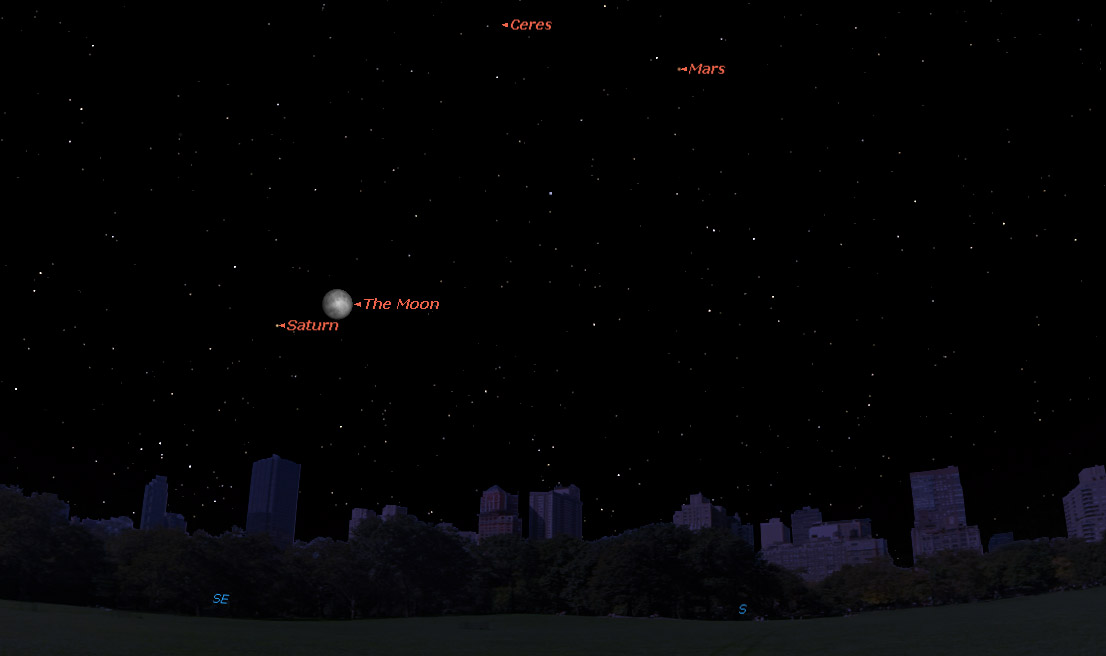
On Tuesday evening (May 13), as the moon, just one night from full phase rises in the east-southeast sky it will be accompanied by a very bright yellowish-white "star" shining off to its lower left. That "star" will be the planet Saturn.
Saturn is currently shining bright in the night sky, just a few days after reaching opposition — its best display for stargazers — on Saturday (May 10). The planet shines at brilliant magnitude of zero on the brightness scale, making it virtually equal to the bright star Arcturus visible high above Saturn.
There is a distinct difference between Saturn and Arcturus though. While both are roughly of the same brightness (Saturn is just a trifle fainter) Arcturus twinkles and glimmers with an orange hue compared to Saturn which shines with a steady and sedate yellowish-white color. [Amazing Night Sky Photos by Stargazers (May 2014)]
So despite its relative close proximity to the moon, Saturn will still manage to stand-out quite well. And what will be especially interesting will be to watch how the moon seems to approach Saturn during the course of the overnight hours.
At dusk on Tuesday, Saturn will appear about 5.5 degrees to the lower left of the moon. (Your closed fist held out at arm's length covers about 10 degrees of the night sky). The moon will move toward Saturn at its own apparent width (one-half degree) per hour during the night.
So by dawn on Wednesday (May 14), the Saturn and the moon will be low in the west-southwest, the moon having moved to within 2.5 degrees to the lower right of the ringed planet. More interestingly, from the southern half of Australia, New Zealand and Victoria Land (Antarctica), the moon will occult (hide) Saturn on Wednesday evening.
On May 10, Saturn reached opposition, rising in the east-southeast at dusk and arriving at its highest point in the middle of the night as a bright spectacle in the southern sky. Saturn set in the west-southwest at dawn.
Get the Space.com Newsletter
Breaking space news, the latest updates on rocket launches, skywatching events and more!
Saturn's famous rings appear much more impressive than in recent years, since they are now tipped by 21.5 degrees from edge on with their northern face in view. A telescope magnifying at least 30-power will be needed to bring them into view. The rings are continuing to open toward a maximum of almost 27 degrees in 2017.
Editor's Note: If you take an amazing photo of Saturn, or any other night sky view, that you'd like to share for a possible story or image gallery, please contact managing editor Tariq Malik at spacephotos@space.com.
Joe Rao serves as an instructor and guest lecturer at New York's Hayden Planetarium. He writes about astronomy for Natural History magazine, the Farmer's Almanac and other publications, and he is also an on-camera meteorologist for News 12 Westchester, N.Y. Follow us @Spacedotcom, Facebook and Google+. Original article on Space.com.
Join our Space Forums to keep talking space on the latest missions, night sky and more! And if you have a news tip, correction or comment, let us know at: community@space.com.

Joe Rao is Space.com's skywatching columnist, as well as a veteran meteorologist and eclipse chaser who also serves as an instructor and guest lecturer at New York's Hayden Planetarium. He writes about astronomy for Natural History magazine, Sky & Telescope and other publications. Joe is an 8-time Emmy-nominated meteorologist who served the Putnam Valley region of New York for over 21 years. You can find him on Twitter and YouTube tracking lunar and solar eclipses, meteor showers and more. To find out Joe's latest project, visit him on Twitter.









